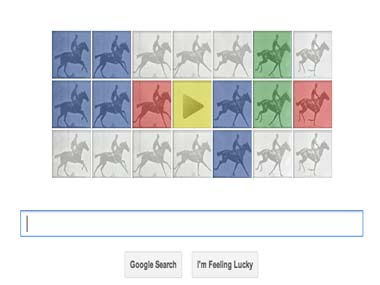[caption id=“attachment_269862” align=“alignleft” width=“380” caption=“Muybridge pioneered videography and the flexible film strip”]  [/caption] Users logging on to Google this morning saw its logo replaced by a 21 square grid each featuring an image of a horse in various stages of a gallop. A play button in the centre animated the horses movements making it look as though it were galloping in slow motion. A quick mouse over the doodle informed users that it was the 182nd birthday of Eadward J Muybridge. Eadward J Muybridge may not be an immediately recognizable name, but he pioneered several interesting studies on animal locomotion and pioneered a machine called the zoopraxiscope, a device for projecting motion pictures that pre-dated the flexible perforated film strip. Muybridge was especially instrumental in settling a popularly-debated question of the day: whether all four of a horse’s hooves are off the ground at the same time during the trot. Wikipedia states that in 1877, Muybridge settled Stanford’s question with a single photographic negative showing Stanford’s Standardbred trotting horse Occident airborne at the trot. Later he used a series of large cameras that used glass plates placed in a line, each one being triggered by a thread as the horse passed. This negative was lost, but it survives through woodcuts made at the time. By 1878, spurred on by Stanford to expand the experiment, Muybridge had successfully photographed a horse in fast motion. Another series of photos taken at the Palo Alto Stock Farm in Stanford, California, is called Sallie Gardner at a Gallop or The Horse in Motion, and shows that the hooves do all leave the ground simultaneously — although not with the legs fully extended forward and back, as contemporary illustrators tended to imagine, but rather at the moment when all the hooves are tucked under the horse as it switches from “pulling” with the front legs to “pushing” with the back legs. This series of photos stands as one of the earliest forms of videography.
Eadward Muybridge pioneered videography, the flexible film strip and was instrumental in settling a hotly debated topic of his time: If all four of a horses hooves left the ground at the same time while running.
Advertisement
End of Article


)

)
)
)
)
)
)
)
)



